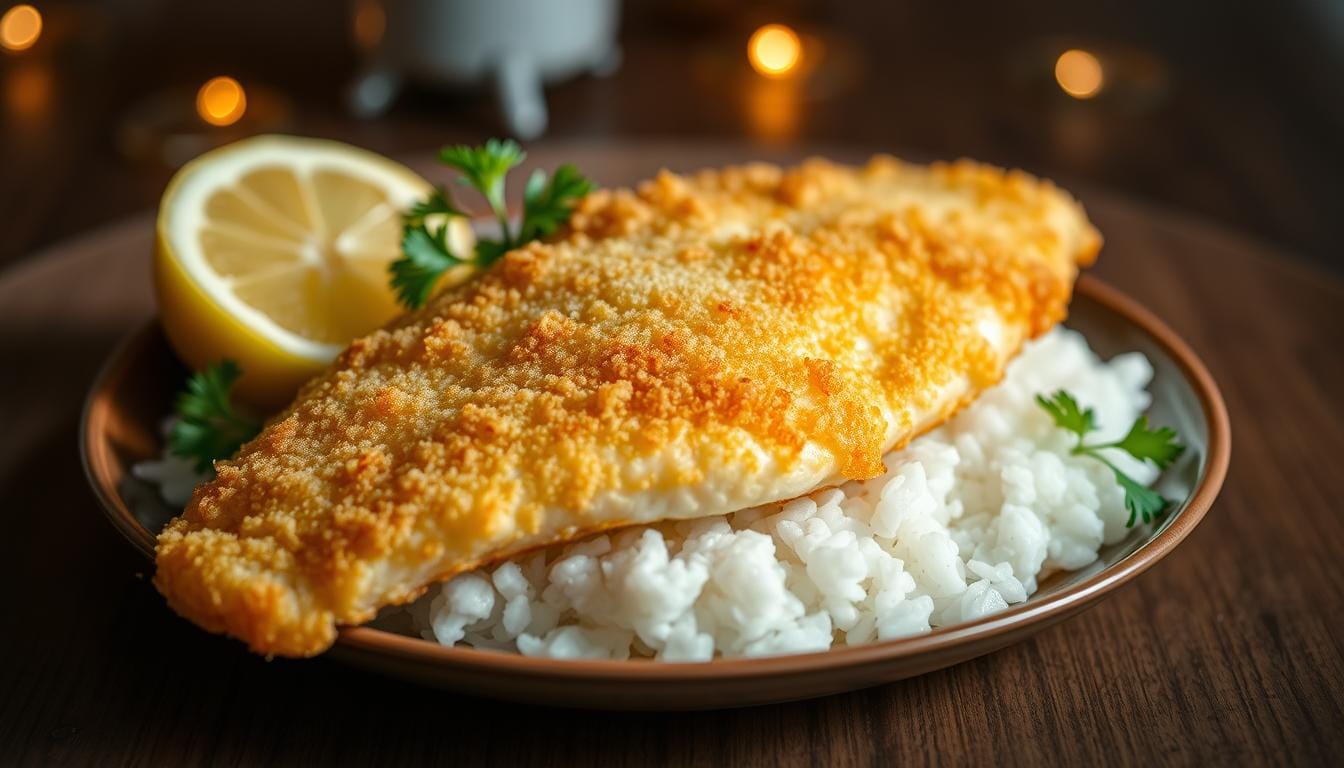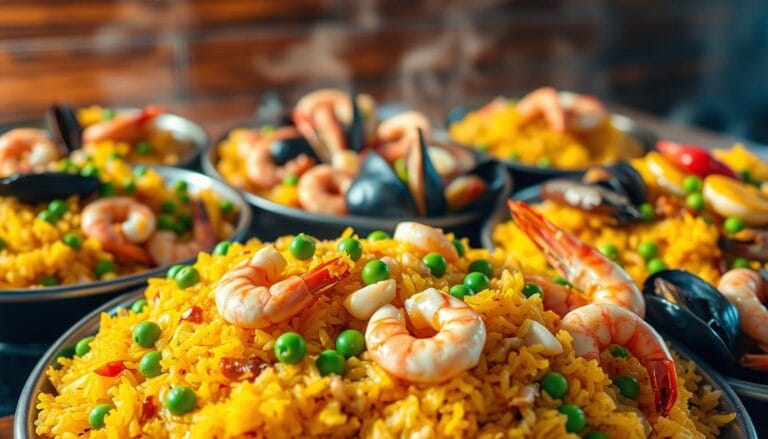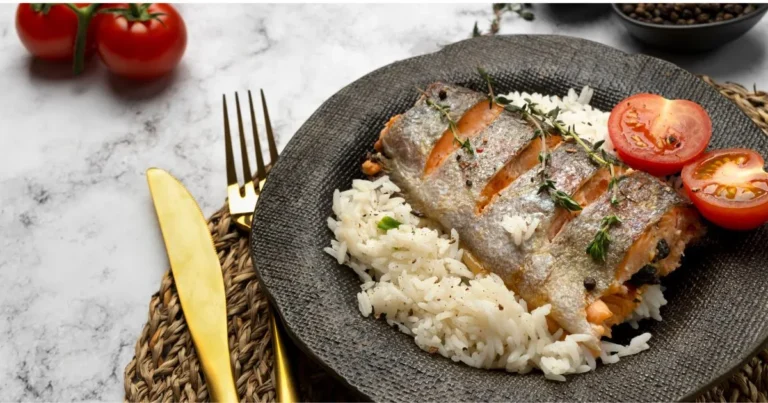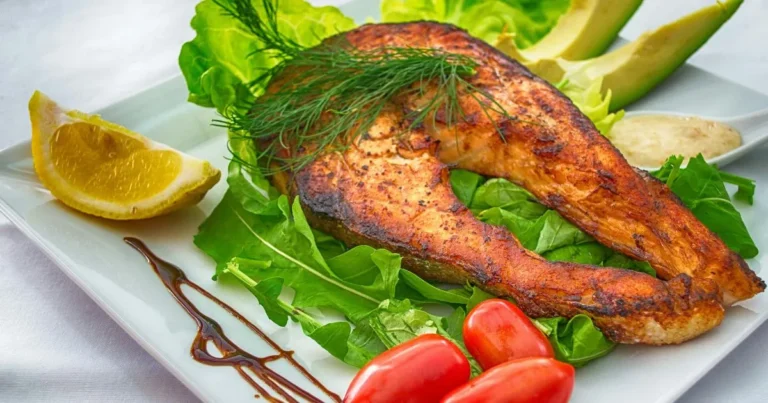4 Tips for Perfect Battered Cod Every Time
Table of Contents
4 Tips for Perfect Battered Cod Every Time
Growing up near the New England coast, I learned that crispy fish is more than a meal. It’s a culinary art form. Battered cod connects us to generations of seafood traditions. It turns a simple piece of fish into a golden, crispy masterpiece.
Making perfect battered cod takes skill, patience, and insider techniques. Whether you’re a home cook or a seafood lover, mastering this dish can take your cooking to new heights. It will transport your taste buds to coastal kitchens.
In this guide, you’ll learn four key tips for battered cod. You’ll get a crispy exterior and a tender, flaky interior. These strategies will change your seafood cooking experience.
Key Takeaways
- Learn professional techniques for creating crispy battered cod
- Understand the importance of fish selection and preparation
- Master the art of creating the perfect batter consistency
- Discover how oil temperature impacts your final dish
- Explore multiple cooking methods for battered cod
Tip 1: Choose the Right Type of Cod for Battering
Choosing the right cod is key to making great fish and chips. Not all cod is the same. Knowing the differences can make your dish better.
The quality of your cod is very important for a tasty fish and chips meal. Fresh cod tastes and feels better. But, frozen cod can also be great if thawed right.
Fresh vs. Frozen Cod: What You Need to Know
Knowing the difference between fresh and frozen cod helps you choose better:
- Fresh cod tastes and feels better
- Frozen cod can be delicious if thawed right
- Choose firm, white-fleshed fish with little color change
Sustainable Sourcing Options
It’s important to eat seafood in a way that protects the ocean. Here are some ways to do that:
| Certification | What to Look For |
|---|---|
| Marine Stewardship Council (MSC) | Wild-caught fish from sustainable fisheries |
| Aquaculture Stewardship Council (ASC) | Responsibly farmed fish with little environmental harm |
“The best fish and chips start with selecting high-quality, responsibly sourced cod.”
By focusing on quality and sustainability, you’ll make fish and chips that’s tasty and good for the planet.
Tip 2: Prepare the Cod for Battering
Getting your cod ready is key to making delicious breaded cod. It turns simple fish into a crispy, tasty treat. Your family and friends will love it.
Thawing Frozen Cod Properly
Thawing frozen cod right is important. Here’s how to keep it tender and flavorful:
- Take the cod out of the freezer and put it in the fridge
- Let it thaw slowly for 24 hours for every 4-6 ounces
- Don’t thaw it at room temperature to avoid bacteria
- Use cold water for quicker thawing, changing it every 30 minutes
Trimming and Drying the Fish
For the best breaded cod, prepare it well. Start by trimming off unwanted parts and drying it.
| Preparation Step | Purpose | Technique |
|---|---|---|
| Trimming | Remove skin and bones | Use sharp kitchen scissors or a fillet knife |
| Drying | Ensure crispy batter | Pat fish dry with paper towels thoroughly |
| Seasoning | Enhance flavor | Lightly salt before battering |
Pro tip: Dry the cod fillets well with paper towels. Too much moisture makes the batter soggy, not crispy.
By doing these steps, you’ll make breaded cod that’s crispy outside and juicy inside. It’s like a restaurant dish at home.
Tip 3: Create the Ultimate Batter
Making the perfect batter is key to delicious beer-battered fish. It turns simple cod into a crispy, tasty treat that seafood fans will love.
The secret to a great batter is choosing the right ingredients and getting the right consistency. Here’s what you need for amazing beer-battered fish:
Selecting Ingredients for the Perfect Batter
- Use a 2:1 ratio of flour to cornstarch for optimal texture
- Choose all-purpose flour as your primary base
- Add 2 tablespoons of cornstarch for extra crispiness
- Include 1 teaspoon of baking powder for lightness
Achieving the Right Consistency
Your batter should be like pancake batter – smooth and even. Pro tip: Aim for a liquid volume of about ½ cup, adjusting as needed. The goal is a batter that’s just right, not too thick or too thin.
Flavor Enhancements to Consider
Make your beer-battered fish even better with these seasonings:
- 1 teaspoon salt
- ½ teaspoon black pepper
- 1 teaspoon garlic powder
- ½ teaspoon paprika
For more flavor, try using a light beer or ale in your batter. The carbonation makes it lighter and crisper. Serve it with homemade tartar sauce for a perfect seafood meal.
Chill your batter for 15-30 minutes before frying to achieve maximum crispiness!
Tip 4: Heat Your Oil to the Perfect Temperature
To get the ultimate crispy fish, mastering oil temperature is key. The right heat makes all the difference. It turns fried fish into a golden, crispy masterpiece.
Getting the oil temperature just right is crucial. It makes your fish crispy and impressive. Professional chefs use temperature control to make their fried fish stand out.
Importance of Oil Temperature
The ideal temperature for frying cod is between 350-375°F (175-190°C). Here’s why temperature is so important:
- Too low: Your fish will soak up too much oil and get greasy
- Too high: The outside will burn before the inside is cooked
- Just right: You get a crispy, golden outside and a moist inside
Using a Thermometer for Accuracy
A kitchen thermometer is your best friend for crispy fish. It helps you avoid guesswork and ensures great results every time.
| Temperature Range | Cooking Result |
|---|---|
| Below 350°F | Soggy, oil-saturated fish |
| 350-375°F | Perfect crispy fried fish |
| Above 375°F | Burnt exterior, undercooked interior |
Pro tip: Always let your oil heat up to the right temperature before adding your battered cod. This ensures a crispy coating that everyone will love.
How to Achieve a Crispy Texture
Creating the perfect crispy fish is more than just frying breaded cod. It’s about using advanced battering techniques. These techniques turn simple fish into a crunchy treat.
Professional chefs know the secret to ultra-crispy fish. It’s all about the right preparation and ingredients. With these expert tips, your breaded cod will be incredibly crunchy.
Double Battering Technique
The double battering method is key to a crispy fish coating. Here’s how to do it:
- First, coat the cod in seasoned flour
- Dip into a cold beer batter
- Return to flour for a second coating
- Shake off excess to prevent clumping
The Role of Cornstarch and Flour
Understanding ingredient science is crucial for a crispy fish coating. Mixing flour and cornstarch improves the texture of your breaded cod.
| Ingredient | Quantity | Purpose |
|---|---|---|
| All-Purpose Flour | ½ cup + 2 tbsp | Base structure |
| Cornstarch | ½ cup | Reduces gluten, increases crispiness |
| Ice-Cold Lager | 1 cup | Adds lightness to batter |
Cornstarch is vital for crispy fish. It reduces gluten, making the coating lighter and crunchier. Less gluten means a lighter, crunchier coating that will make your breaded cod irresistible.
Different Cooking Methods for Battered Cod
Preparing a delicious seafood dish like fish and chips requires mastering various cooking techniques. Understanding different methods can help you create the perfect battered cod that suits your dietary preferences and kitchen setup.
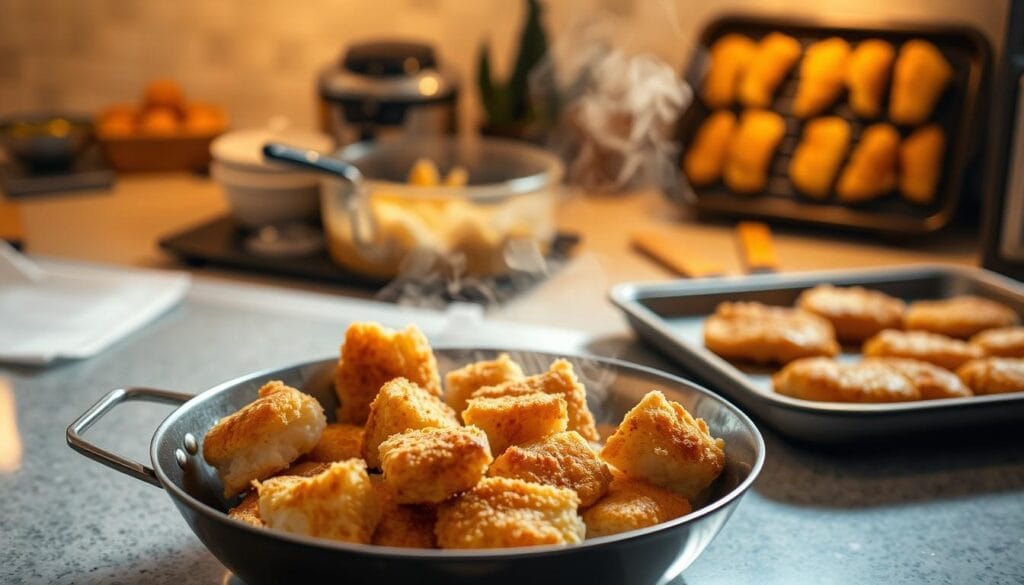
Deep Frying for the Classic Finish
Deep frying remains the quintessential method for creating traditional fish and chips. To achieve the perfect golden-brown exterior, maintain your oil temperature between 350-375 degrees Fahrenheit. This technique ensures a crispy, delectable seafood dish that captures the authentic flavor.
- Use canola or vegetable oil with high smoke points
- Shake off excess batter before frying
- Avoid overcrowding the pan
Air Frying for a Healthier Option
Air frying offers a lighter alternative to traditional deep frying. You can achieve a crispy texture with significantly less oil, making it an excellent choice for health-conscious seafood lovers.
Pro tip: Preheat your air fryer and lightly spray the battered cod with oil for best results.
Oven Baking for a Less Oily Alternative
Oven baking provides another method for preparing battered cod with reduced oil content. Preheat your oven to 425 degrees Fahrenheit and place the fish on a wire rack for optimal crispiness.
- Arrange battered cod on a lined baking sheet
- Bake for 15-20 minutes until golden brown
- Check internal temperature reaches 145 degrees Fahrenheit
Whichever method you choose, the key is maintaining the right temperature and avoiding moisture to create a perfectly crispy fish and chips experience.
Serving Suggestions for Battered Cod
Creating the perfect fish and chips experience is more than just cooking the cod. The right accompaniments and presentation can make your meal amazing. Let’s see how to make your battered cod taste like it’s from a restaurant.
Perfect Pairings: Sauces and Sides
Your battered cod needs great friends. Here are some classic choices:
- Homemade tartar sauce – the ultimate condiment for fish and chips
- Crispy golden french fries
- Tangy coleslaw
- Lemon wedges for a bright, citrusy touch
To make an amazing homemade tartar sauce, mix mayonnaise, chopped pickles, fresh dill, and lemon juice. This simple sauce will go great with your crispy battered cod.
Presentation Tips to Impress Guests
Presentation can make your fish and chips look as good as they taste. Try these tips:
- Use a newspaper-lined basket for an authentic pub-style look
- Garnish with fresh herbs like parsley
- Serve on wooden boards for a rustic feel
- Stack fries alongside the fish for visual appeal
Remember, we eat with our eyes first. A well-presented plate of battered cod will make your meal feel like a special treat.
Common Mistakes to Avoid
Preparing crispy fish needs precision and care. Even skilled cooks can make mistakes that affect the quality of their battered cod. Knowing these common errors will help you make dishes that taste like they’re from a restaurant.
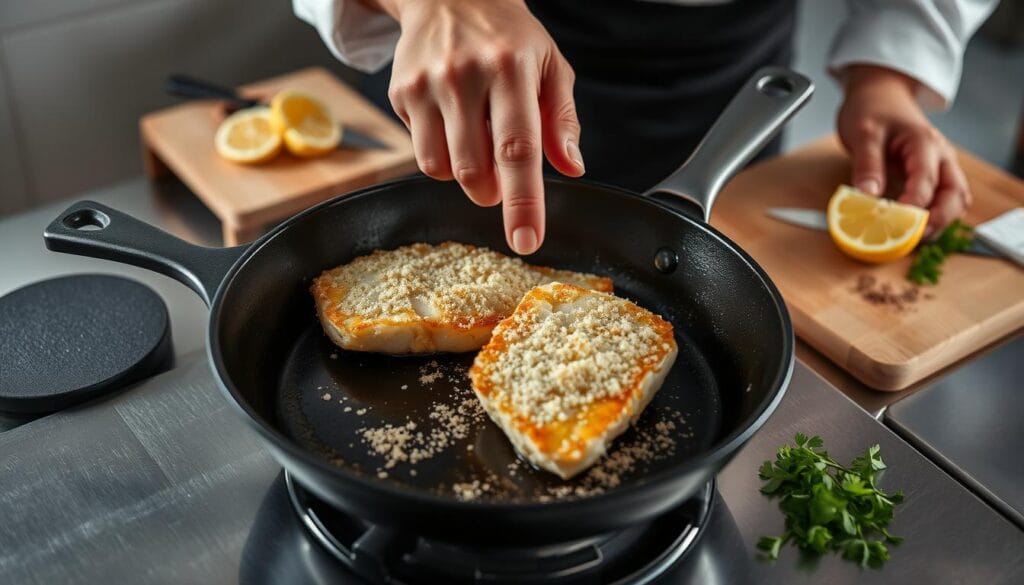
Two big mistakes can mess up your battered cod: overcrowding the fryer and not mixing the batter right. These errors can turn your crispy fish into a greasy, disappointing meal.
Overcrowding the Fryer: A Recipe for Disaster
Putting too many pieces of battered cod in the fryer at once causes several issues:
- Dramatic temperature drop in the oil
- Uneven cooking of the fish
- Increased oil absorption
- Soggy, less appetizing battered cod
“The key to crispy fish is maintaining consistent oil temperature and giving each piece enough space to cook properly.”
The Art of Batter Mixing
Mixing your batter needs a gentle touch. Overmixing can make the coating tough and chewy instead of light and crispy.
- Mix ingredients just until combined
- Avoid aggressive stirring
- Let batter rest for 10-15 minutes before use
- Use cold ingredients for better texture
By avoiding these common mistakes, you’ll improve your battered cod. Remember, great cooking is about technique and patience.
Storage Tips for Leftover Battered Cod
Keeping your seafood dish fresh after cooking is key. Leftover fried fish stays tasty and safe with the right storage and reheating methods.
Best Practices for Keeping Fried Fish Fresh
Storing your battered cod properly is essential. Here are the steps to follow:
- Cool the fried fish completely before storing
- Use airtight containers to prevent moisture buildup
- Refrigerate within two hours of cooking
- Store in the refrigerator for 3-4 days maximum
Reheating Methods to Maintain Crispiness
Here are the best ways to reheat your seafood dish:
| Reheating Method | Temperature | Cooking Time | Tips |
|---|---|---|---|
| Air Fryer | 350°F (160-175°C) | 6-7 minutes | Flip halfway, avoid overcrowding |
| Conventional Oven | 350-375°F (180°C) | 14-18 minutes | Place on wire rack for even heating |
Always heat your fried fish to 63°C (145°F) for safety. Pro tip: Don’t reheat seafood more than once to avoid bacterial growth.
Freezing Options for Long-Term Storage
Freezing is great for keeping battered cod longer. Wrap it tightly in freezer-safe packaging and store for up to two months. Thaw in the fridge overnight before reheating.
Benefits of Making Battered Cod at Home
Preparing fish and chips at home has many benefits. It’s not just about saving money. You’ll also enjoy the thrill of creating your own homemade battered cod.
- Cost-effective alternative to restaurant dining
- Complete control over ingredient quality
- Ability to customize flavors and seasonings
- Opportunity to perfect your cooking techniques
Cost-Effectiveness Breakdown
When you cook fish and chips at home, you’ll save a lot. A meal at a restaurant can cost $15-$20 per person. But, making it at home can be as cheap as $5 per serving.
| Expense Category | Restaurant Cost | Homemade Cost |
|---|---|---|
| Cod Fillets (6 oz) | $10 | $4 |
| Batter Ingredients | Included in meal | $1.50 |
| Cooking Oil | Included | $0.50 |
| Total Meal Cost | $20 | $6 |
Customization and Flavor Exploration
When you make your own tartar sauce and try different batter recipes, you can really personalize your dish. You can change spices, try different beer batters, or even use healthier cooking methods like air frying.
Home cooking isn’t just about saving money—it’s about crafting an experience that reflects your unique taste and creativity.
By mastering battered cod at home, you’ll save money and learn valuable cooking skills. These skills will turn a simple meal into a special dining experience.
Final Thoughts on Perfecting Battered Cod
Learning to make battered cod is a fun journey. It turns a simple dish into a tasty meal. You’ll need patience, practice, and a spirit to try new things. Every chef started with mistakes in the kitchen.
Getting good at battered cod means knowing about batter, oil, and fish. Each time you make it, you’ll get better. The most important thing is to enjoy the learning and the yummy food.
We want to hear about your battered cod adventures. Share your favorite seasonings or frying tips. Cooking brings people together through great food.
Keep working on your battered cod recipe. Remember, the best cooking comes from passion, creativity, and learning. Your kitchen is where you experiment and get better. Soon, you’ll make a dish that will wow everyone.

